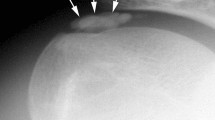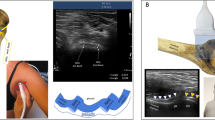Abstract
Objective
Assess extensor carpi ulnaris (ECU) tendon position in the ulnar groove, determine the frequency of tendon “dislocation” with the forearm prone, neutral, and supine, and determine if an association exists between ulnar groove morphology and tendon position in asymptomatic volunteers.
Materials and methods
Axial proton density-weighted MR was performed through the distal radioulnar joint with the forearm prone, neutral, and supine in 38 asymptomatic wrists. The percentage of the tendon located beyond the ulnar-most border of the ulnar groove was recorded. Ulnar groove depth and length was measured and ECU tendon signal was assessed.
Results
15.8 % of tendons remained within the groove in all forearm positions. In 76.3 %, the tendon translated medially from prone to supine. The tendon “dislocated” in 0, 10.5, and 39.5 % with the forearm prone, neutral and supine, respectively. In 7.9 % prone, 5.3 % neutral, and 10.5 % supine exams, the tendon was 51–99 % beyond the ulnar border of the ulnar groove. Mean ulnar groove depth and length were 1.6 and 7.7 mm, respectively, with an overall trend towards greater degrees of tendon translation in shorter, shallower ulnar grooves.
Conclusions
The ECU tendon shifts in a medial direction when the forearm is supine; however, tendon “dislocation” has not been previously documented in asymptomatic volunteers. The ECU tendon medially translated or frankly dislocated from the ulnar groove in the majority of our asymptomatic volunteers, particularly when the forearm is supine. Overall greater degrees of tendon translation were observed in shorter and shallower ulnar grooves.






Similar content being viewed by others
References
Chang CY, Huang AJ, Bredella MA, Kattapuram SV, Torriani M. Association between distal ulnar morphology and extensor carpi ulnaris tendon pathology. Skelet Radiol. 2014;43:793–800.
Campbell D, Campbell R, O’Connor P, Hawkes R. Sports-related extensor carpi ulnaris pathology: a review of functional anatomy, sports injury and management. Br J Sports Med. 2013;47:1105–11.
Cone RO, Szabo R, Resnick D, Gelberman R, Taleisnik J, Gilula LA. Computed tomography of the normal soft tissues of the wrist. Investig Radiol. 1983;18:546–51.
Pfirrmann CW, Theumann NH, Chung CB, Botte MJ, Trudell DJ, Resnick D. What happens to the triangular fibrocartilage complex during pronation and supination of the forearm? Analysis of its morphology and diagnostic assessment with MR arthrography. Skelet Radiol. 2001;30:677–85.
Lee KS, Ablove RH, Singh S, De Smet AA, Haaland B, Fine JP. Ultrasound imaging of normal displacement of the extensor carpi ulnaris tendon within the ulnar groove in 12 forearm-wrist positions. AJR Am J Roentgenol. 2009;193:651–5.
Pratt RK, Hoy GA, Bass Franzcr C. Extensor carpi ulnaris subluxation or dislocation? Ultrasound measurement of tendon excursion and normal values. Hand Surg Int J Devoted Hand Up Limb Surg Relat Res J Asia-Pac Fed Soc Surg Hand. 2004;9:137–43.
Hunt TR, Wiesel SW. Operative techniques in hand, wrist, and forearm surgery. Philadelphia: Wolters Kluwer Health/Lippincott Williams & Wilkins; 2011.
Cooney WP. The wrist: diagnosis and operative treatment. Philadelphia: Wolters Kluwer/Lippincott Williams & Wilkins Health; 2010.
Sole JS, Wisniewski SJ, Newcomer KL, Maida E, Smith J. Sonographic evaluation of the extensor carpi ulnaris in asymptomatic tennis players. PM R. 2015;7:255–63.
Burgess RA, Pavlosky WF, Thompson RT. MRI-identified abnormalities and wrist range of motion in asymptomatic versus symptomatic computer users. BMC Musculoskelet Disord. 2010;11:273.
Acknowledgements
The authors would like to thank James Babb, PhD and Mary Bruno, BSc.
Author information
Authors and Affiliations
Corresponding author
Ethics declarations
Conflict of interest
The authors declare that they have no conflict of interest.
Rights and permissions
About this article
Cite this article
Petchprapa, C.N., Meraj, S. & Jain, N. ECU tendon “dislocation” in asymptomatic volunteers. Skeletal Radiol 45, 805–812 (2016). https://doi.org/10.1007/s00256-016-2352-4
Received:
Revised:
Accepted:
Published:
Issue Date:
DOI: https://doi.org/10.1007/s00256-016-2352-4




